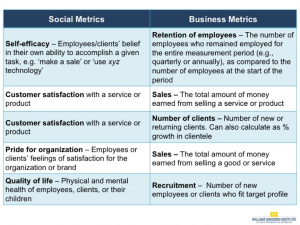Hi, we’re Rebecca Baylor, Heather Esper and Yaquta Fatehi from the William Davidson Institute at the University of Michigan (WDI). Our team specializes in performance measurement. We use data to improve organizations’ effectiveness, scalability, and sustainability and create more value for their stakeholders in low- and middle-income countries.
We believe combining social and business metrics helps organizations– including impact investors– gain unique insights to solve key business challenges while communicating impact evidence. Through our work, we have encountered a number of social + business metric ‘power couples’ that we’ve seen influence internal decision-making at organizations to improve results.
Hot Tip: Create a few social + business metric power couples. Analyze business and social metrics in parallel. Use data to see how your organization should holistically adapt to better meet its goals and increase intended impacts.
 Lessons Learned: Finding the right metrics can be a lot like parenting. Selecting metrics takes time and patience. There isn’t one perfect formula, and it will likely evolve over time. However, organizations, including businesses, use some of the following strategies to make their job easier:
Lessons Learned: Finding the right metrics can be a lot like parenting. Selecting metrics takes time and patience. There isn’t one perfect formula, and it will likely evolve over time. However, organizations, including businesses, use some of the following strategies to make their job easier:
- Get Creative – Turns out, what works for one kid– or project– may not work for the next. Innovate. Brainstorm what matters most. To select the right combination metrics, ask: what insights do we need? What are our key challenges? Use ‘pause and reflect’ sessions to examine data across different teams. RAD RESOURCE: FSG’s Intentional Group Learning Guide
- Pretest – Would you buy your child new sneakers without trying them on first? Didn’t think so! Don’t expect spectacular data insights to come from metrics you haven’t tested first. RAD RESOURCE: Conducting a Successful Pretest
- Be Strategic – There is a reason why Child A doesn’t raise Child B. If you want business and social metrics that generate lessons and guide decision-making, you have to place parents– senior-level leadership– in the driver’s seat. The Boston Consulting Group’s article, Total Societal Impact: A New Lens for Strategy, offers an enlightening perspective on pursuing social impacts and business benefits simultaneously.
- Be Rigorous, Yet Right-sized – At bath time, one scrub behind the ear may not be enough to get the dirt away. Conversely, spending 3 hours soaked in suds is effective but unrealistic. MIT D-Lab’s Lean Research Framework is a great place to look for guiding principles to effective, right-sized research.
What are we missing? For starters, environmental impacts– but that’s another blog for another time. What Social + Business metric combinations have or haven’t worked for you? We would love to hear from your experiences! Send us your thoughts. The more we share and learn from one another, the more impact we can generate.
The American Evaluation Association is celebrating Social Impact Measurement Week with our colleagues in the Social Impact Measurement Topical Interest Group. The contributions all this week to aea365 come from our SIM TIG members. Do you have questions, concerns, kudos, or content to extend this aea365 contribution? Please add them in the comments section for this post on the aea365 webpage so that we may enrich our community of practice. Would you like to submit an aea365 Tip? Please send a note of interest to aea365@eval.org. aea365 is sponsored by the American Evaluation Association and provides a Tip-a-Day by and for evaluators.

My background is both as an external auditor as well as working within numerous government and profit-oriented organizations. I am also an educator, currently in a M.Ed program studying evaluation and your blog post provides excellent advice and resources, along with humorous analogies.
When instructing my classes, we often discuss social and business metrics, which we term Q&Q (short for thinking of qualitative and quantitative metrics of performance), now to be renamed ‘power couples’ in your blog’s honor as it is an excellent analogy for encouraging a more holistic assessment of an organization’s performance.
Your blog provided excellent tools for helping an organization strategize and evaluate for internal decision making. As you noted, these points are also relevant for external stakeholders.
From my audit background, the focus for external stakeholders, in addition to assessing the organization, is to assess the metrics themselves. Are the metrics appropriate and valid? Do they capture the organization’s challenges and performance or is there a potential bias in the assessment? Are they comparable to previous years? Along these lines, I want to share another RAD RESOURCE: https://www.cpacanada.ca/en/business-and-accounting-resources/strategy-risk-and-governance/corporate-governance/publications/kpis-a-tool-for-audit-committees
Red flags:
You asked in your blog about sharing experiences about metric ‘power couples’. I want to share some red flags from my experience that indicate that the power couples may be having some relationship difficulties. In other words, a few indicators that the organization is having difficulties that may not be seen initially through traditional metrics:
– Higher sales returns or reversals in the quarter after reporting – possible indication of sales being recorded incorrectly or attempts to overstate earnings to improve the reported performance metric
– Inefficient or lack of IT policies and procedures (potential red flag – high use of Excel or googledocs without coordination) – possible indication of higher risk of error, confidential information not being protected, risk of data corruption, which can all affect the various metrics
– Higher staff turnover especially if low to mid-level staff – possible indication of being overworked, underpaid, a lack of training, a lack of proper staffing plans, and/or corporate culture issues, which will adversely affect social and business metrics overall.
Thank you for sharing the insights and resources for effective metric development and pairings.
Keri Norrie